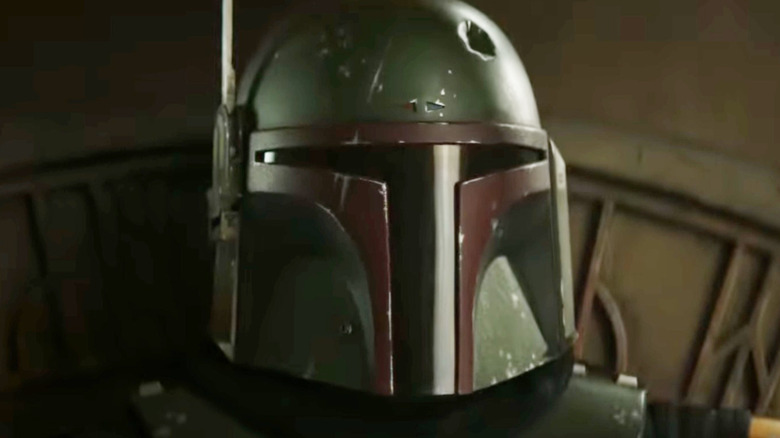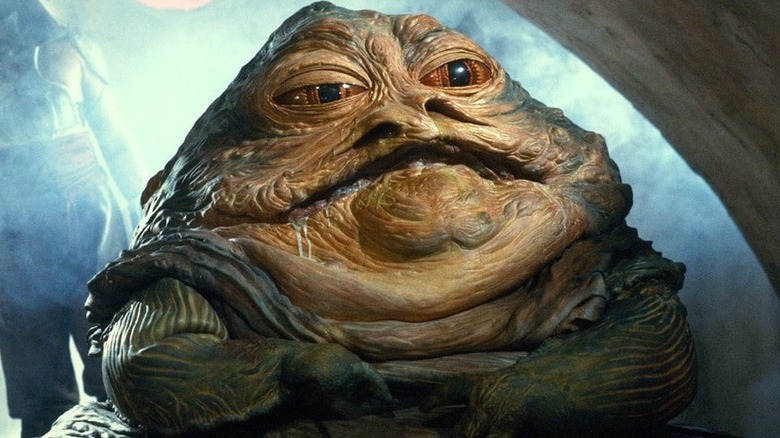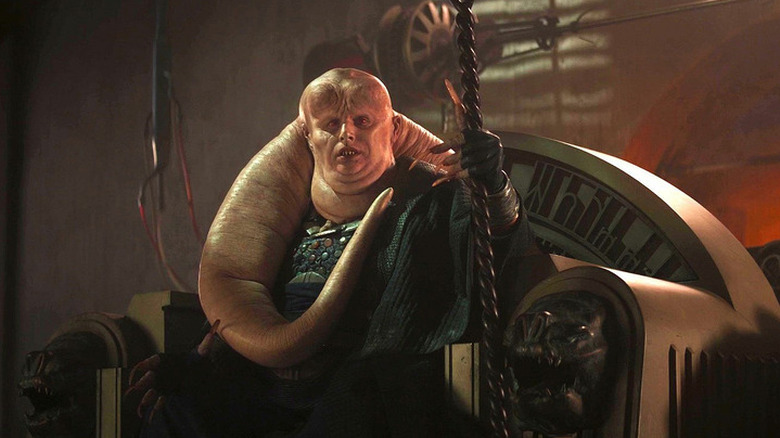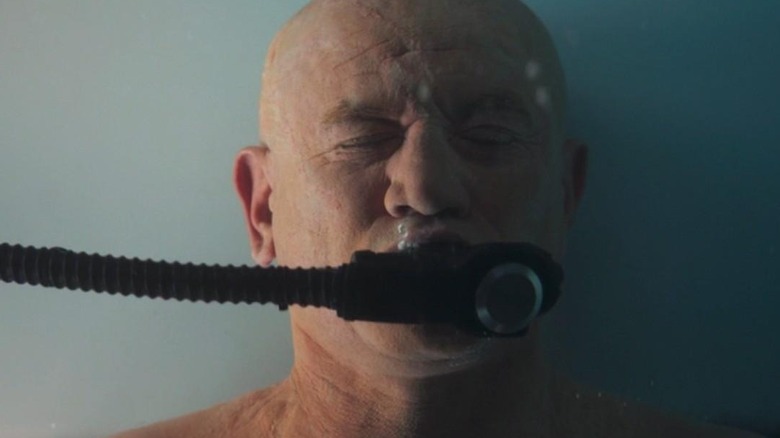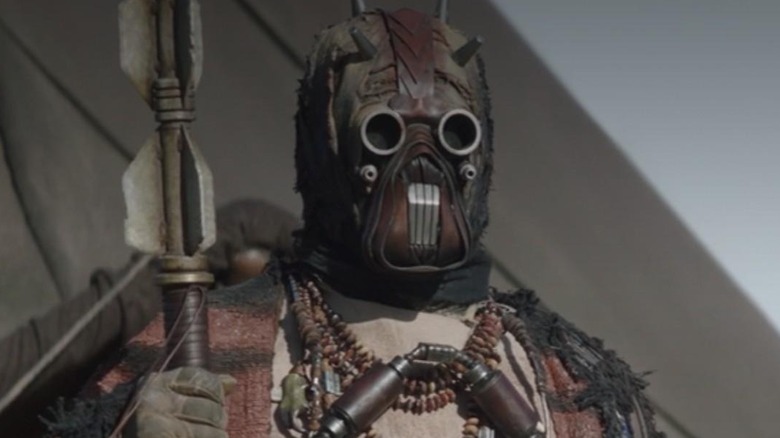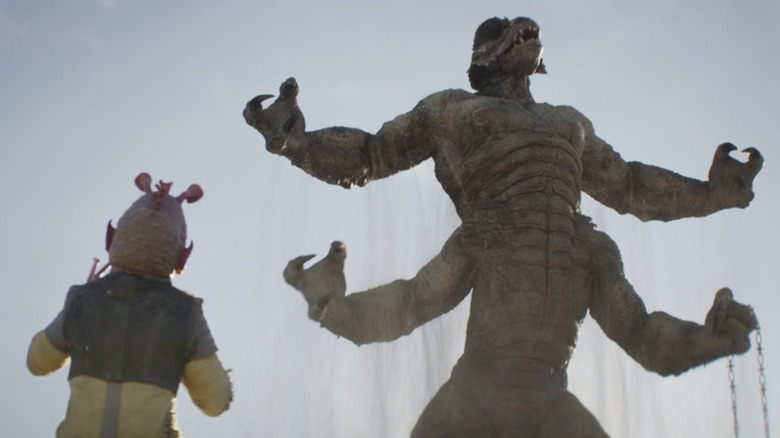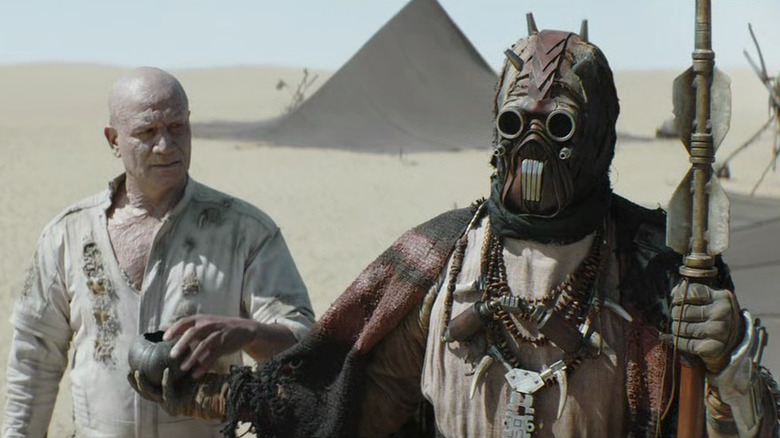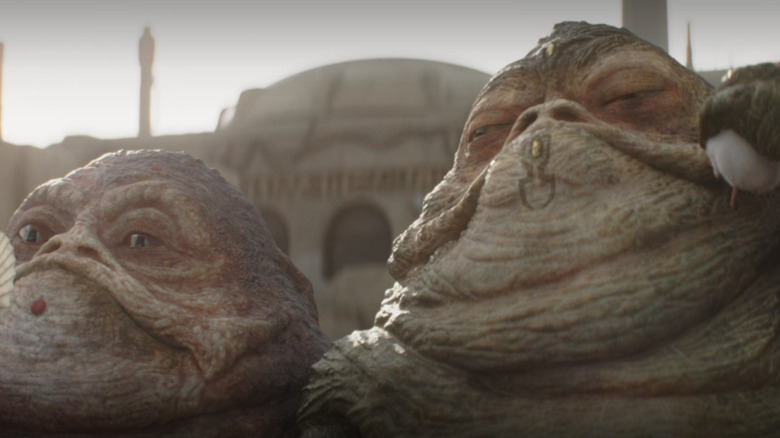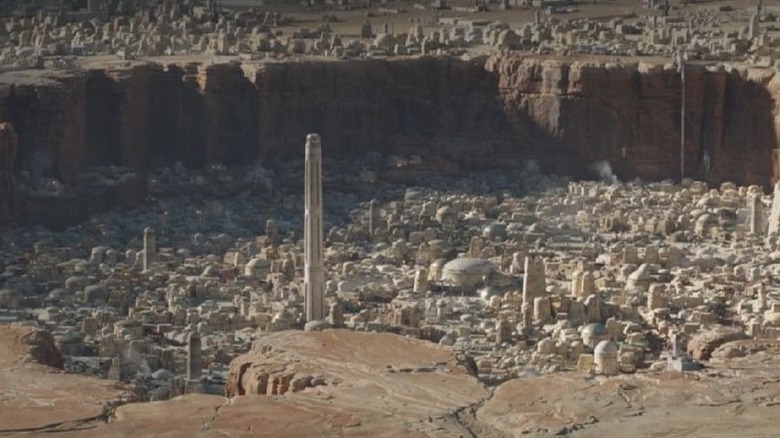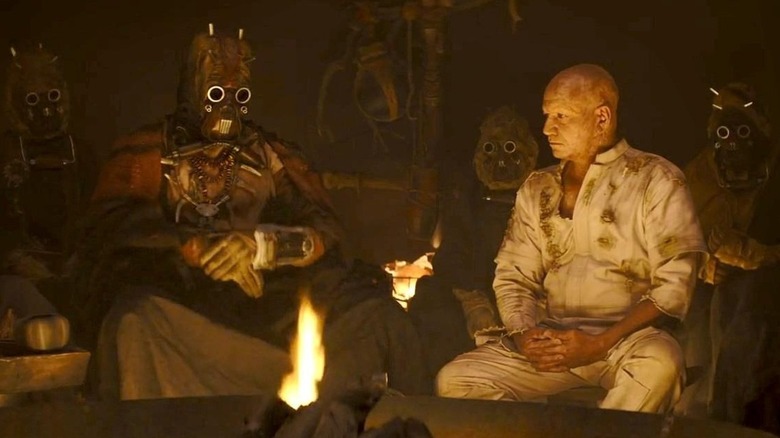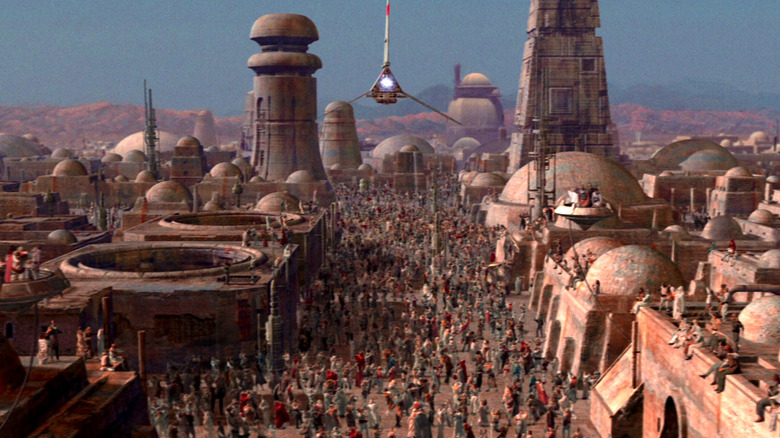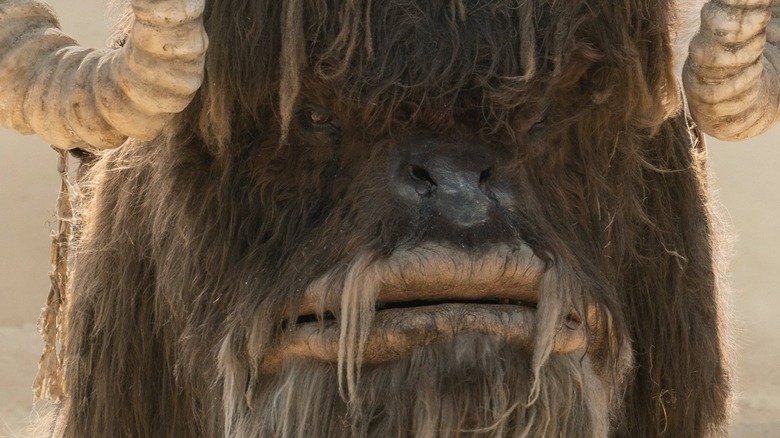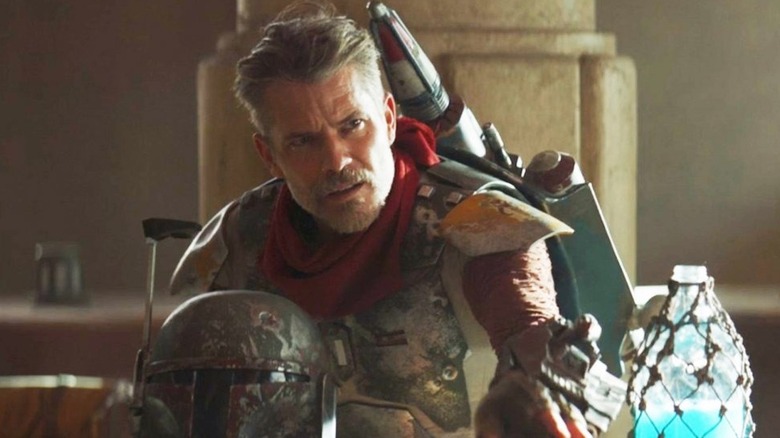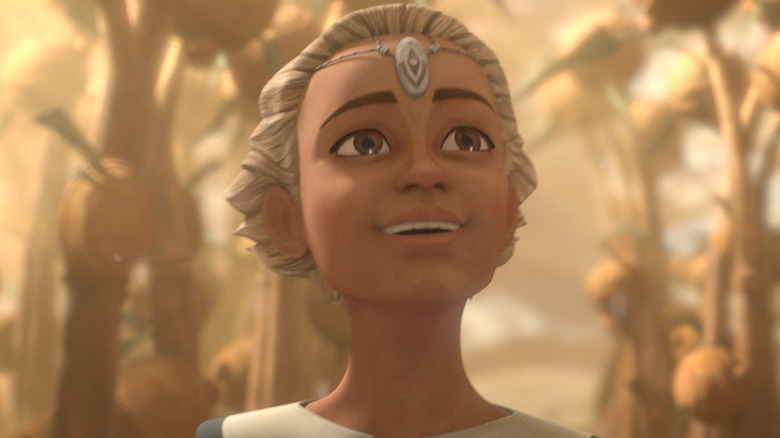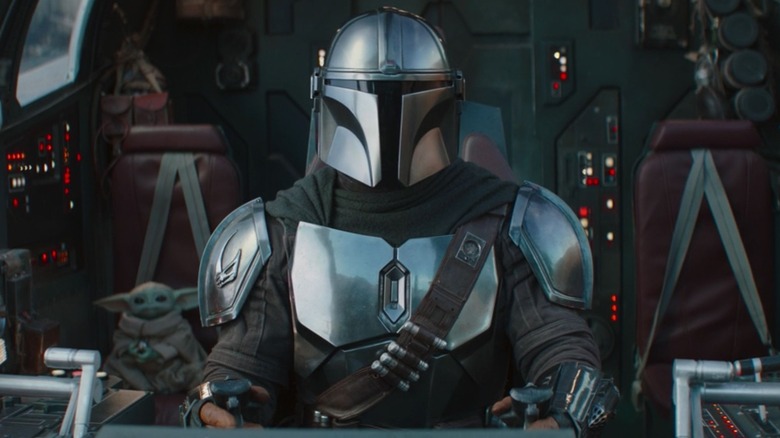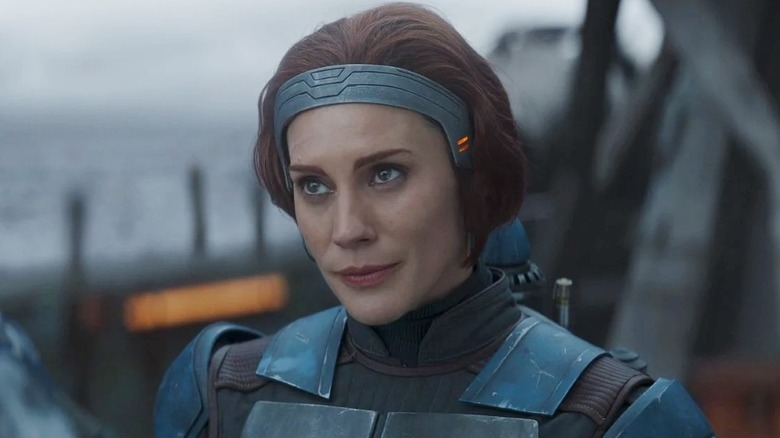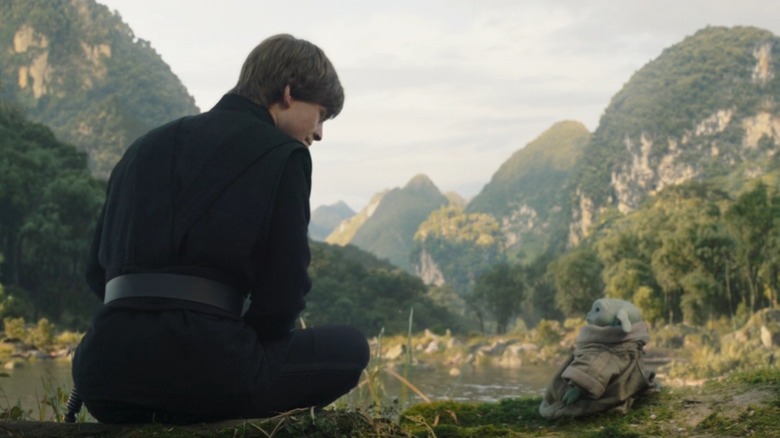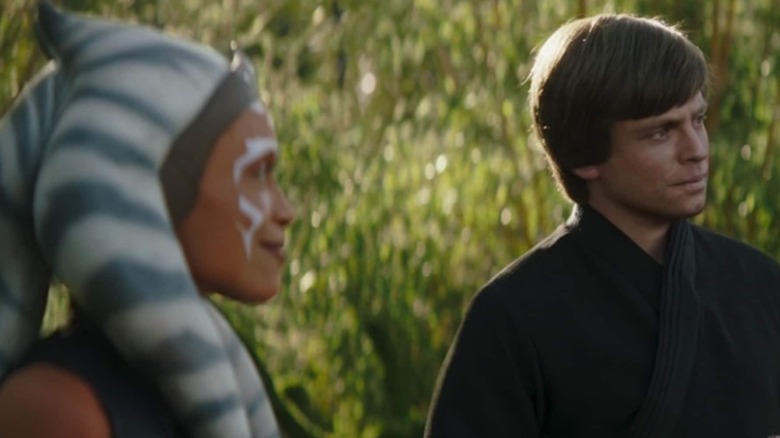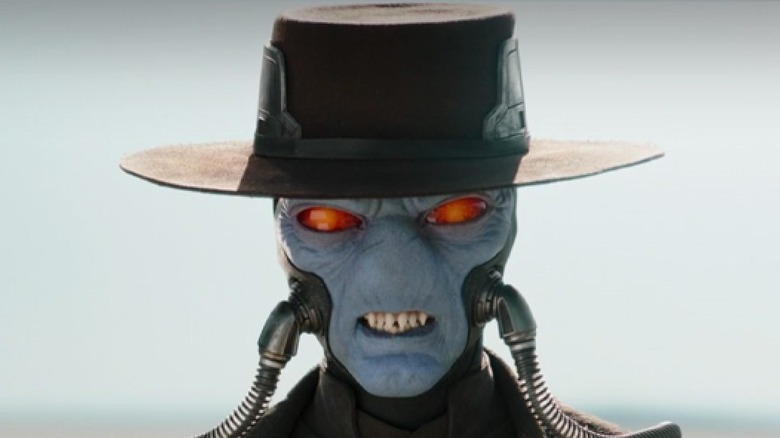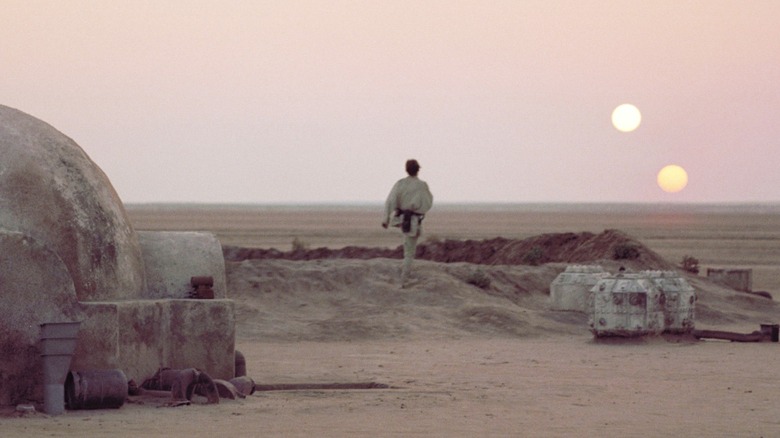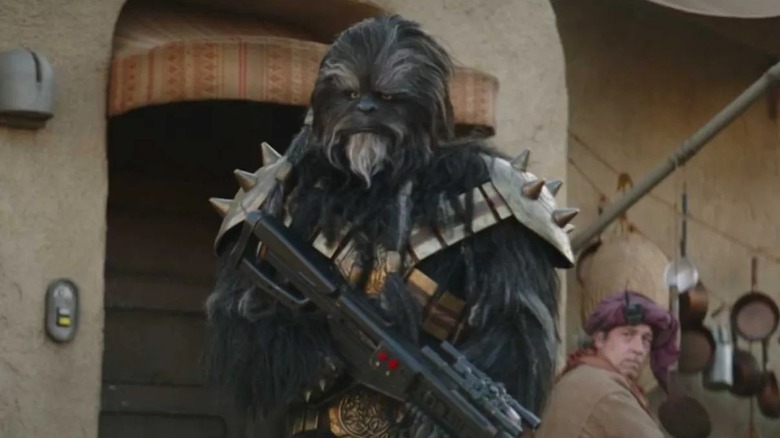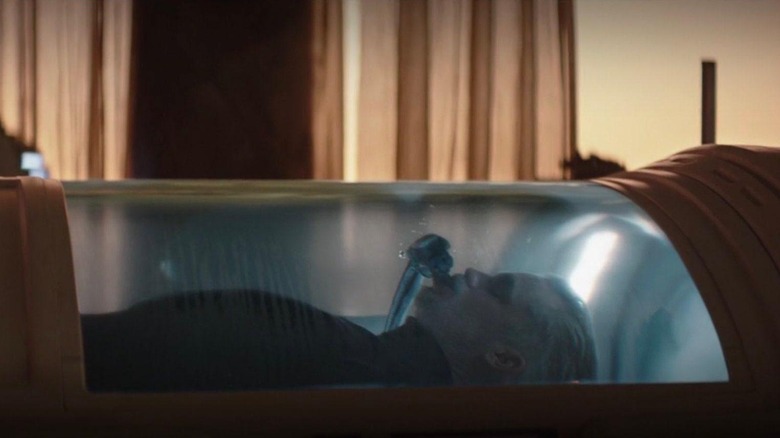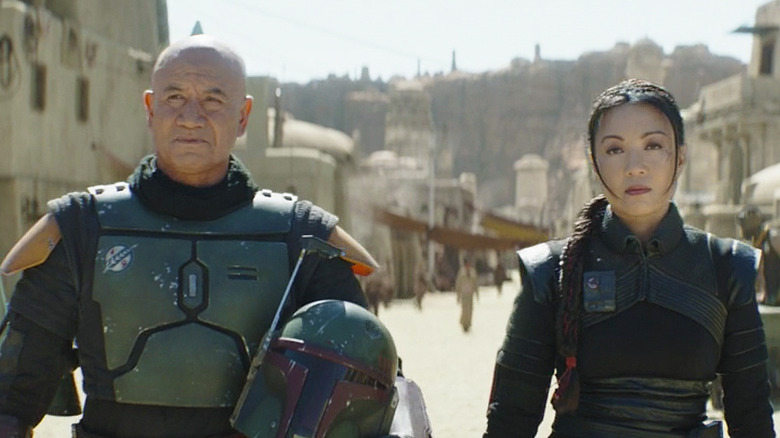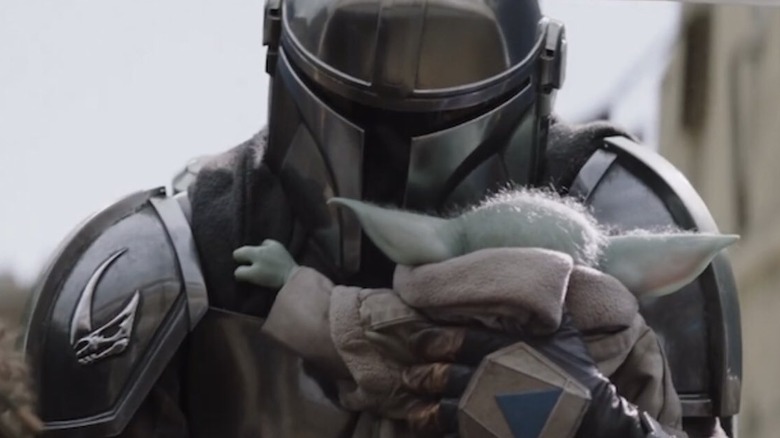Biggest Unanswered Questions In The Book Of Boba Fett
After decades of reigning as one of the most popular characters in the entire "Star Wars" universe, Boba Fett finally has his own live-action series in Disney+'s "The Book of Boba Fett." Technically a spinoff from "The Mandalorian," the new show follows the adventures of Boba (played by Temuera Morrison) and his companion Fennec Shand (Ming-Na Wen) a few years after the end of "Return of the Jedi." Together, the two take control of Jabba the Hutt's old criminal dominion on Tatooine and attempt to spread their influence across the galactic underworld.
From the start, "The Book of Boba Fett" is loaded with potential. The crime syndicates, smugglers, and bounty hunters who run the shadier corners of the galaxy have historically borne some of the franchise's most fun and compelling stories. Most of the core "Star Wars" films focus more on the Jedi and the Sith than on the politics of the Outer Rim, but recent stories like "The Mandalorian" and "The Bad Batch" have found great success showing the parts of the universe that characters like Boba Fett call home.
From the first episode, "The Book of Boba Fett" fills in a lot of gaps about the titular bounty hunter's life and the world he inhabits. However, the series also creates some new questions alongside the answers it provides. Some previously unexplored parts of the "Star Wars" timeline remain shrouded in mystery, and new characters and conflicts have brought new questions with them. Here are the biggest unanswered questions from "The Book of Boba Fett."
What exactly happened after Jabba the Hutt died?
After a long career of terrorizing the fringe corners of the "Star Wars" galaxy, Jabba the Hutt met his end on his own desert sail barge. Specifically, he was strangled to death by Princess Leia, and then blown to smithereens — an appropriately explosive way to go for one of the most feared mobsters ever to rule the Outer Rim.
But after Jabba died, what happened to his empire? "The Mandalorian" season 2 reveals that Jabba's right-hand man Bib Fortuna took over the palace and general operations in his stead, and "The Book of Boba Fett" has offered a bit more clarification on that transition of power. However, there's still not much explanation for what all happened in the interim years. "The Mandalorian" spends a lot of time explaining how Tatooine was plunged into chaos after the destruction of the second Death Star, which implies Fortuna's regime was less dominant than Jabba's. And yet, the palace, the guards, and many of the systems of extortion the Hutt relied on are all waiting when Fett and Fennec show up.
How did Bib Fortuna hold power for so long?
Perhaps the bigger question regarding the aftermath of Jabba's death isn't what happened exacctly, but how Bib Fortuna managed to stay at the center of it all. In "Return of the Jedi," Fortuna is portrayed as a subservient wax man –- hardly the kind of character who could effectively run a criminal empire. Boba Fett and Fennec Shand manage to walk right into his palace and take him out with no problems at all at the end of "The Mandalorian" season 2. So how did Fortuna last for years sitting on Jabba's old throne, and why were Fett and Shand the first opponents to try to take him down?
It's possible that others came in the interim years to try to take Jabba's palace and simply failed for one reason or another, but it's difficult to imagine Fortuna and his meager staff fending off invaders. Other Hutts arrive almost immediately after Boba makes his takeover public and demand that he cede the territory back to them, so why didn't they take the palace back from Fortuna before? Or was he simply a pawn for the greater Hutt Empire the whole time — a placeholder daimyo who was just keeping everything in order for the eventual Hutt return to Tatooine?
Is Boba Fett sick?
Boba Fett starts his show resting in a bacta tank — a healing apparatus seen many times throughout the "Star Wars" franchise. In fact, he spends a good deal of time in the tank. Ostensibly, his healing sessions are solely meant to repair the wounds he suffered in the Sarlacc Pit — work that is completed by the end of Episode 4. However, Fett's heavy reliance on the bacta tank could be hinting at even more grave danger for the bounty hunter. Put another way, the amount of time Fett seems to be spending in there — something he seemed to be fine without in "The Mandalorian" Season 2 — could suggest he has a long-term illness or chronic health issue.
That might seem like a bit of a jump in logic, except for the fact that Boba is still biologically a clone of Jango Fett. While he did not receive the growth acceleration or other genetic modifications that the clones who fought for the Republic did — modifications that led to severe health problems later in life — he could still be subject to some unanticipated side effects of the cloning process. Alternatively, Boba could have sustained some sort of injury in the intervening years that simply hasn't been shown yet. Either way, the bounty hunter doesn't seem to be in the greatest shape.
What is the history of the Tusken Raiders?
George Lucas' portrayal of Tusken Raider society was problematic to say the least, a portrait of indigenous peoples as savage, violent, and barely human. The Disney "Star Wars" era has done some work here and there to remedy those issues, largely through more nuanced and human portrayals of Tuskens in "The Mandalorian." "The Book of Boba Fett" continues that trend in big ways by exploring the Tusken tribe that finds Boba after he escapes from the Sarlacc pit; They are a group of desert dwellers who have hard and occasionally brutal ways, but also a clear political structure, a thriving culture filled with rich tradition, and a necessary set of values (read: strength) for their inhospitable environment.
Even with the new bits of lore about how the Sand People live, however, there's still a lot we don't know. Tatooine has been more explored and fleshed out than any other planet in the "Star Wars" universe, and because the Tuskens are so central to the story of Tatooine, it would be nice to keep developing a better understanding of their society, history, and customs. It remains to be seen exactly how much "The Book of Boba Fett" will deliver in that regard, but the show has already taken some big steps in the right direction. There have already been allusions to the ancient history of Tatooine, its former ecology before the sands took over, and how the Tuskens were pushed to desperate lifestyles by the intrusions of more and more foreigners.
What is the sand creature that Boba Fett kills?
At the end of "The Book of Boba Fett" Episode 1, Boba proves his mettle to the Tusken Raiders by killing a monster buried in the Tatooine sands. The "Star Wars" franchise has spent a good deal of time on the desert planet and shown a wide range of the native wildlife, from banthas and krayt dragons to the almighty Sarlacc. However, this new sand creature hasn't appeared before, making it something of a mystery in Tatooine's otherwise familiar ecosystem.
The reptilian monster Boba Fett slays is almost centaur-like in its physiology, with four hind legs supporting an upright torso and two more arm-like muscular limbs. Whatever it is, the monster seems to sleep beneath the sand in an attempt to stay cool from Tatoonie's hot twin suns, likely coming to the surface only to hunt and feed. It seems unlikely that there will be (or needs to be) any greater explanation for the sand monster, but it's always fun to see a new creature added to the vast "Star Wars" menagerie.
How many Tusken tribes are there?
"The Book of Boba Fett" makes it clear that there are many different Tusken Raider tribes that vary in their specific cultures, practices, and morals. There seem to be many common practices and traditions across all or most of these disparate tribes, but the Tusken society as a whole is very decentralized. How many tribes and individual Tuskens actually live on Tatooine? That's never been made entirely clear, and after what's been revealed in "The Book of Boba Fett," it seems less likely than ever that the other residents of Tatooine have any real idea of what goes on in the Dune Sea when they're not around.
Is a union between the different Tusken tribes possible? Could they leverage their strength and unmatched knowledge of the planet to take back a hold on their ancestral territory? Possibly. In all likelihood, that's not a story Disney will be telling any time soon, but Boba Fett's relationship with the Tuskens has opened up some interesting possibilities for the Sand People going forward.
How powerful is the Hutt Empire after Jabba's death?
Though Jabba may be dead during "The Book of Boba Fett," his kin are still alive and well, and a couple of them show up to challenge Boba's claim to Jabba's territory soon after he takes over the palace. There was a time when the Hutts were the most feared criminal organization in the galaxy, but after several were killed or imprisoned during the Clone Wars and others like Jabba fell during the Imperial era, their sphere of influence must have shrunk substantially. How substantially, exactly? That's not entirely clear.
"The Book of Boba Fett" is positioned perfectly to add some fun new lore to the Hutts and explore previously unknown aspects of their criminal rule, but a lot of that info — including how they fared following Jabba's demise — remains a mystery. Clearly, the Hutts still hold significant respect in "The Book of Boba Fett," as the Twins are guarded by the feared Wookie bounty hunter Black Krrsantan, a popular character from Marvel's "Star Wars" comics. Power in the Outer Rim always seems to be in flux in "Star Wars," and with Boba Fett suiting up for possible war against the remaining Hutts, there could be another big shift coming soon.
What happened to Tatooine?
The Tuskens Boba Fett joins up with allude to an ancient history of Tatooine that's previously only been vaguely hinted at in "Star Wars" media. The tribe's leader mentions a time when the Dune Sea was an actual sea, before the waters of the planet turned to sand and the whole world became an inhospitable desert. It was then that the Tuskens began hiding in the wastes and adopting more brutal ways as off-worlders kept coming to plunder their land for profit.
So how did Tatooine go from a water-ridden paradise to the desert world "Star Wars" fans know? It's unclear, and though "The Book of Boba Fett" has provided some additional explanations for the state of the planet, it's unlikely that we'll be getting a complete history of Tatooine any time soon. Still, it's fun to get a few new bits and pieces about the planet's past, and how it came to host so many of the most famous "Star Wars" moments.
What's up with the trippy Tusken brain lizards?
After proving his worth to the Tusken tribe that saved his life, Boba Fett is put through what seems to be a rite of passage -– a psychedelic fever trip caused by a mysterious lizard that enters Boba's cranium. After receiving the lizard, Boba wanders through the desert in a daze, eventually happening upon an ancient tree. He returns to the tribe with a branch from the tree, which he then turns into a gaffi stick with the help of his new friends.
It's a bizarre and incredibly striking scene, and it begs some new questions about the Tusken Raiders and the barren landscape they call home. How does the lizard, well, work? How does it know to bring its host to one of Tatooine's trees, which are exceedingly rare? How does it even know where they are?
Obviously, this is the kind of lore detail that's probably better off without any concrete explanation. It adds a fun layer of mystique to Tatooine, even if it rips off yet another part of "Dune" to do so.
Why is Tatooine so valuable?
"The Book of Boba Fett" shows that Tatooine is just as much a hub for intergalactic scum and villainy as it ever was in the New Republic era, with Boba and his crew, the Hutts, the Pike Syndicate, and other nefarious forces all vying for control of the Mos Espa territory. But why? Why is this barren, desert town seen as being so valuable by so many people, to the point that they're willing to go to war for it?
To be clear, Tatooine has a lot of innate value for enterprising individuals. Mining operations have littered the planet off and on for much of the "Star Wars" timeline, and because of Tatooine's Outer Rim location, it's a natural center for lucrative illegal activities. But why Mos Espa specifically? Maybe all parties involved see Jabba's palace as a symbol of power -– sign that whoever holds it rules not just the surrounding territory, but Tatooine as a whole and all the operations that go on under its suns. That was the case with Jabba, after all,
Still, the importance that the galaxy's criminals seem to place on Tatooine seems a bit overinflated for what the planet actually is. That doesn't mean that an in-depth explanation of the territory's exact value is at all necessary, but it would help to have a more firm understanding of why people are so willing to fight and die for this particular spot of rock and sand.
How much do banthas eat?
After being saved by one of the Tusken tribes of Tatooine, Boba Fett adopts many of their customs, even after they're tragically killed and he once again starts traveling alone. One of those customs is the use of banthas for transportation across the Dune Sea. The giant, wooly creatures were first introduced in the original "Star Wars," and they've remained staples of the franchise ever since. Boba has a tender relationship with his own bantha while he's living in the planet's desert wastes, even sharing food with the animal by his campfire. However, the amount that Boba feeds his bantha seems shockingly insufficient for the creature's massive size, which raises the question: How much do banthas actually eat?
Tatooine is a pretty lifeless world, all things considered. The animals who can survive there are generally well-conditioned to the harsh climate and often spend a good deal of time hibernating beneath the sand. Banthas don't have that luxury, but it's possible they simply have an extremely efficient metabolism that allows them to survive on very little sustenance. It's hard to imagine an animal so big and heavy managing to thrive in the middle of the desert, but clearly, banthas are right at home in the Dune Sea. It was sad to see Boba let his own hairy friend go, but he surely won't be the last bantha to feature prominently in a "Star Wars" story.
How did Boba Fett find his armor?
In "The Mandalorian" Season 2, Boba Fett reclaims his beskar steel armor from Din Djarin, who himself acquired it from the self-proclaimed marshal of Tatooine, Cobb Vanth. Vanth took the armor from the Jawas who stole it off Fett's body after he escaped the Sarlacc — a crime shown early in "The Book of Boba Fett." But in all the effort to bridge the gap between "Return of the Jedi" and "The Mandalorian," we still haven't seen how Boba tracked down his armor in the first place.
He knows Din has it because he watches him take it from Cobb Vanth, but neither show reveals how he discovered that the marshal acquired his armor. The most likely explanation is that rumors of a man wearing Mandalorian armor reached Boba Fett somewhere else on Tatooine, prompting him to investigate for himself and eventually track Vanth down. But even then, it doesn't make sense that Boba would wait to claim the armor. Did he only discover Vanth's location just as Din Djarin was taking the armor from him? Or did he have some other reason to hesitate?
Ultimately, these details aren't all that crucial to the story, but it still seems a little odd that "The Book of Boba Fett" leaves them up to the viewer's imagination when it explicitly outlines so much else.
Where is Omega during The Book of Boba Fett?
In "The Book of Boba Fett" Episode 4, Boba and Fennec Shand spend a lot of time laying plans and preparing for their impending war with the Pike Syndicate — a powerful intergalactic crime family that has laid claim to Jabba the Hutt's old Tatooine territory. In their discussion of how best to defeat the Pikes, Fennec suggests they spend some of Fett's extensive stores of credits to hire some professional help. Because of Fennec's recurring role in the "Star Wars" animated series "The Bad Batch," this conversation conjures questions of whether any members of Clone Force 99 are still alive, and if so, where they are.
Of course, the most likely "Bad Batch" character to return in the "Book of Boba Fett" era is his own "sister," Omega, who's just a child at the end of the Clone Wars. Like Boba, who was codenamed "Alpha" by the Kaminoans, Omega was given no growth augmentation in her cloning process. Accelerated aging is the main reason that most Jango Fett clones are dead by the end of the original "Star Wars" trilogy, but that would never have been a problem with Omega.
Given the information that's currently available in the canon, it's hard to say where exactly Omega might be, or if she's even still alive. Nonetheless, it seems highly likely that the character could debut in live action at some point in the future.
How will Din Djarin return to Mandalore?
"The Book of Boba Fett" continues Mandalorian bounty hunter Din Djarin's story beyond the end of "The Mandalorian" Season 2, and things aren't going so great for him. He's clearly saddened by the absence of Grogu, who he left with Luke Skywalker to train as a Jedi, and when he returns to his old Mandalorian covert, he's quickly expelled for breaking their code. Specifically, because Din admits to having removed his helmet in the presence of others — an act that is strictly forbidden among a certain sect of Mandalorians — he's kicked out, though he continues to carry the Darksaber. The Mandalorian armorer who leads the covert tells him that the only way to absolve himself is to bathe in the waters of Mandalore's old mines, which were destroyed during the Empire's Great Purge of the planet.
That seems like a storyline setup for "The Mandalorian" Season 3, if there ever is one, but how and when will Din make his way back to the Mandalorian homeworld? The planet has yet to be seen on screen since the events of the Purge, and "The Book of Boba Fett" shows just how devastating the Empire's genocidal attack truly was. Returning to such a wasteland could be dangerous in all sorts of ways. Who could be hiding in the rubble of Mandalore? Is it even possible to gain access to the destroyed mines? And what about Bo-Katan Kryze, whose mission is to take the planet back?
Where is Bo-Katan Kryze?
"The Mandalorian" Season 2 ends with a clear tension established between Din Djarin and Bo-Katan. The events of their battle with Moff Gideon end with Din unintentionally winning the Darksaber in combat, and the Mandalorian code states that Bo-Katan — who wants the Darksaber and the authority it brings for herself — would have to defeat him fairly to earn it back. Clearly, she wasn't ready to challenge Din at the time because he's walking free when he shows back up in "The Book of Boba Fett." But because Bo-Katan seems so singularly minded when it comes to the Darksaber, it's only a matter of time before she shows back up.
Bo-Katan won't stop until she gets the Darksaber and retakes Mandalore, but she also won't take it without winning it properly this time. That sets her and Din on a collision course, and if his own journey is now taking him back to Mandalore, it could come to a head sooner rather than later. But what exactly happened between them at the end of "The Mandalorian" Season 2? Did she let him go? Is she keeping tabs on him in secret? Surely she wouldn't let the Darksaber disappear from her sight again, which suggests she must have some idea what Din is up to. And eventually, the two may have to duel it out.
Will Grogu be as strong as Yoda?
"The Book of Boba Fett" features surprise cameos from Baby Yoda, Luke Skywalker, and Ahsoka Tano when Din Djarin arrives at the site of the new Jedi Temple to deliver his beskar chainmail to the little guy. There's a lot of footage showing Grogu's training, including scenes of Luke imparting wisdom from Master Yoda himself. Given that they are the same species and Grogu is clearly already quite strong in the Force (at least when he chooses to focus), it seems natural to assume that he'll end up being just as strong as Yoda. But will he?
What's shown in "The Book of Boba Fett" certainly looks promising as far as Grogu's power level goes, but there are very few guarantees as to what he will become. The "Star Wars" canon has offered little information about Yoda's species, making it difficult to discern how much of the old master's power was innate to his genes, and how much was unique to him as an individual. And of course, we don't know how quickly Grogu will mature from his current age. It took him 50 years to reach his current level of awareness and maturity, which suggests it could be decades more before he's even able to speak. On the other hand, his growth could speed up the older he gets, allowing him to reach greater power sooner than expected. Right now, we just don't know.
Why is Ahsoka with Luke Skywalker?
When Din arrives to deliver his gift to Grogu, he's greeted by Ahsoka Tano (Rosario Dawson). This should be a bit of a surprise for those who watched "The Mandalorian" Season 2, as Ahsoka seemed pretty occupied with other ventures and uninterested in formal Jedi training. At the time, she was on the hunt for Grand Admiral Thrawn — formerly a powerful military leader of the Galactic Empire — with theories abounding that her real mission was locating "Star Wars Rebels" protagonist Ezra Bridger (per Screen Rant). So why would someone with an urgent, unfulfilled mission and no desire to formally rejoin the Jedi Order be aimlessly hanging around with Luke and Grogu?
Maybe she came to tell Luke some stories of his father, Anakin, who served as her master and instructor during the Clone Wars. Seeing Luke and Ahsoka interact, even just briefly, is pretty fun for anyone who's seen the "Clone Wars" animated series, and it would make sense for Ahsoka to want to pass on some of her own wisdom, as she is notably older than Luke. Alternatively, it's possible that she was there for a more pressing reason. Maybe she needed Luke's help to learn something about the Imperial Remnant, or to magnify her Force sensitivity somehow in order to find Ezra. Hopefully, these questions will be answered when Ahsoka's own Disney+ series eventually premieres.
Where has Cad Bane been since the Clone Wars?
It's always fun to see animated "Star Wars" characters be brought to live action for the first time, and "The Book of Boba Fett" has delivered just that with its reintroduction of notorious bounty hunter Cad Bane. First introduced in "Star Wars: The Clone Wars," Bane worked for the Separatist cause numerous times during the final days of the Republic, often going head-to-head against the Jedi in the process. He shows back up in "Star Wars: The Bad Batch," which is set in the immediate aftermath of Order 66, and he's alluded to in "Star Wars Rebels," but "The Book of Boba Fett" is his first proper appearance in the timeline since the end of the Clone Wars.
So, what has Cad Bane been up to for all that time? That's still unclear. He apparently kept a pretty low profile during the Imperial era, as he doesn't show up personally in "Rebels" or any films in the original trilogy. Even when the Empire hired the toughest bounty hunters in the galaxy to track down Han Solo — a job Boba Fett himself ultimately completed — Cad Bane was nowhere to be found.
Now, it seems that the notorious bounty hunter's wayward journey through the galaxy has come to an end. Boba Fett kills him on screen, striking him through the chest with his gaffi stick. "Star Wars" characters have come back from apparent death before, but that doesn't seem to be in cards for Bane. Fortunately for fans of the character, the massive gaps in his story mean he could still continue to show up in future projects set prior to "The Book of Boba Fett."
How will Tatooine change with the Pikes gone?
By the end of "The Book of Boba Fett," the Pike Syndicate is completely run off Tatooine, as are their spice shipments. Despite the destruction caused by the climactic battle in Mos Espa, the town and the planet at large seem to be on a more peaceful path going forward. But will that pattern hold true? For now, the answer is unclear.
It seems like more and more power will be held by the ordinary citizens of Tatooine, rather than by despotic crime lords and other opportunistic leaders. By the end of the season, the mayor of Mos Espa is dead, Mos Pelgo has rebranded itself as Freetown, and the spice trade is at least temporarily suspended. Could that power-to-the-people movement extend to include the Tuskens as well, given that Boba Fett is now a sort of bridge between the two communities? Possibly. Tensions between the Tuskens and other inhabitants of Tatooine run deep, but with less crime and more cooperation, a permanent peace there may be possible as well.
Of course, a certain amount of scum and villainy seems destined to remain on Tatooine. It's still a major Outer Rim world far from the prying eyes of any real galactic authority, making it ideal for smugglers, bounty hunters, and others of their kind. But if all goes well, the planet could become more of a sanctuary than a wretched hive.
Will will happen to Black Krrsantan?
The fearsome Wookie bounty hunter Black Krrsantan, commonly called Santo, goes from villain to hero over the course of "The Book of Boba Fett." After making an attempt on Fett's life by order of the Hutts, he ends up joining forces with Boba and ultimately stands with him against the Pike Syndicate's attacks. Boba says in the show that he has plenty of money, so it's likely that he's paying Santo handsomely for his services. But now that the war is over, will the Wookie remain in Mos Espa?
Those familiar with the Marvel "Star Wars" comics will know that Krrsantan has had a brutal and violent life. But by the end of "The Book of Boba Fett," he almost seems like part of Boba Fett and Fennec Shand's makeshift crime family. The whole series has a running theme about how you can't be alone forever, and it looks like Krrsantan may have finally found a place he could stay long-term. Until his next "Star Wars" appearance, however, his fate will remain a mystery.
What will happen to Cobb Vanth?
Cobb Vanth, the marshal of Freetown, faced down the notorious bounty hunter and mercenary Cad Bane in "The Book of Boba Fett," ultimately losing their duel and presumably dying from his wounds. However, the post-credits scene of the "Book of Boba Fett" season finale reveals that Vanth may have survived; he is seemingly being preserved in Fett's own bacta tank, waiting to be operated on by the cybernetic modder who saved Fennec Shand (played by Stephen "Thundercat" Bruner).
How many modifications will Vanth require to survive, and what will his role on Tatooine be when he emerges from the tank? Will he return to a quiet life in Freetown? Or will the removal of the Pike Syndicate encourage him to expand his peacekeeping efforts planet-wide? For now, Boba and Fennec seem to have Mos Espa well-protected, but Fett also hints that he has some misgivings about staying and ruling long-term. Maybe a more equitable, permanent partnership could materialize between the two former bounty hunters and Cobb Vanth, leading to a more united Tatooine.
Either way, the marshal is going to get some pretty cool robotic augmentations for whenever he shows up next.
What's next for Boba Fett and Fennec Shand?
Against the odds, Boba Fett and Fennec Shand managed to fight off the Pikes and hold onto their territory in Mos Espa. So what now? Will they stay and rule over a more peaceful, equitable city? Or will they drift back to their old ways, leaving the people of Tatooine to govern themselves?
By the end, Boba seems a bit unsure. "We are not suited for this," he says to Fennec when the dust has settled and the people of Mos Espa are rebuilding their home. "If not us, then who?" she replies. It's a fair question. In a long and violent history, Boba and Fennec are rare examples of people who've helped and protected the citizens of Tatooine. If the planet is to become anything more than a midway stop for criminals and smugglers, it will need leaders with that sort of compassion.
If "The Book of Boba Fett" gets a Season 2, we'll find out what the future holds for Fett, Fennec, and the rest of their motley crew. For now, though, it seems likely that they'll stay, at least for a little while. The season finale draws a stark contrast between Boba — who decides to fight for something meaningful — and his old mentor Cad Bane, who sticks to his creed of self-preservation to the very end. If Boba is to take away any real meaning from their showdown, it should make him inclined towards remaining in Mos Espa.
What's next for the Mandalorian and Grogu?
An oddly large percentage of "The Book of Boba Fett" is dedicated to the story of Din Djarin and Grogu, the main protagonists of "The Mandalorian." Over the course of the season, Grogu leaves his Jedi training with Luke Skywalker and reunites with Din, ultimately helping to stop the Pikes and save Mos Espa. After the battle, the two board the Mandalorian's shiny new Naboo starfighter and head off into space together, bound for more adventures.
What will they get up to next? That's a question for "The Mandalorian" Season 3 to answer. But it seems likely that they'll continue the bounty hunter's lifestyle. Din may try to find his way back to Mandalore to perform the cleansing ritual needed to rejoin his people (having been ousted for removing his helmet in "The Mandalorian" season 2). And as long as he wields the Darksaber, he'll be a target for Bo-Katan Kryze, who wants to win it and the throne of Mandalore for herself.
Whatever happens, Grogu will continue to grow stronger in the Force. Without the rigid structure of Jedi training, his potential is nearly limitless, but he could also suffer from a lack of guidance or even be tempted by the dark side.
Unfortunately for now, fans will have to wait for the next installment of the "Mandalorian" saga to see those next steps for themselves.
